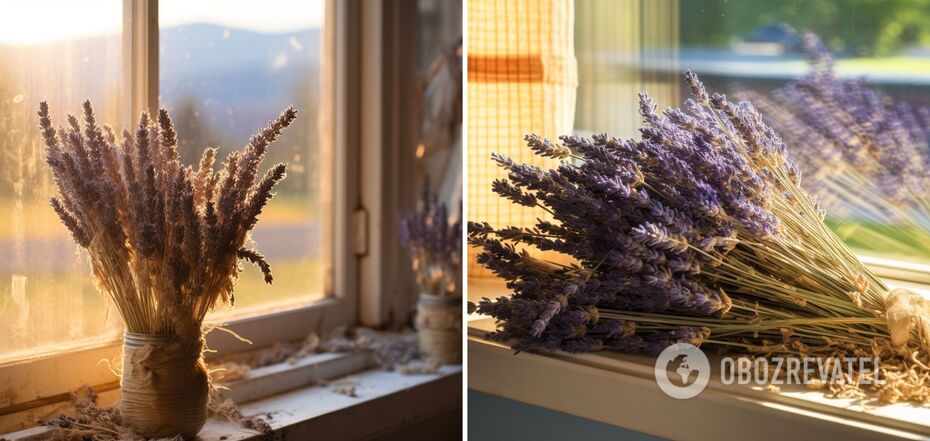Life
How to dry lavender correctly: tips for cutting and preparation
Growing lavender is becoming increasingly popular in Ukraine. The plant feels very good here, makes a great decoration for the site and can bring a lot of benefits if used as food or as a medicinal herb. And this benefit can be increased by properly harvesting, drying and storing this plant.
OBOZREVATEL has collected the main tips for harvesting lavender. Using them, you will get many additional benefits from the fragrant flowering herb.
What is lavender used for?
This plant has long been known for its calming properties. Even its smell helps you relax and fall asleep, let alone in tea or a bath.
In addition, lavender helps relieve spasms and restore muscle tone to normal. In particular, those responsible for vascular function.
The nylon acid contained in the plant helps to stop the blood.
During a cold, lavender tea or the use of the plant's essential oil can help fight infection and remove sputum.
How to harvest lavender correctly
To get the most out of lavender, you need to harvest it properly. Experts advise doing this as follows:
- harvest between June and mid-October - to determine the exact time, ask about the characteristics of the variety you are growing;
- collect only inflorescences with no more than half of the flowers blooming, so they do not crumble during drying and contain a maximum of essential oil and nutrients;
- choose a dry and sunny day for harvesting, preferably one that has been preceded by at least 2-3 days of good weather - the plant should be dry, so it is better to stop watering it in advance, and cut the flowers only after the morning dew has completely evaporated;
- if you can't guess the weather, a protective awning should be pulled over the place where the lavender grows a few days before harvesting;
- if seeds have formed on the plant, it is too late to harvest them - they have lost most of their benefits;
- cut off not only the inflorescences themselves, but also the stems along with the leaves 15-20 centimetres long;
- the cutting tool must be very sharp - dull blades will lead to a waste of nutrients.
How to dry lavender correctly
The best way to prepare for drying is to wilt it. This stage can be skipped if the plant was harvested after a long period of dry weather. In order to wither the cut inflorescences, they are laid out in a single layer on a dry, flat surface in a well-ventilated place. You need to turn the lavender every 3-4 hours. After a maximum of 10 hours, the leaves will lose their elasticity, after which the plant can be dried. An important caveat: if you want to dry lavender for decorative purposes, you need to place it in dark conditions - this way it will not fade and the flowers will retain their bright colour.
Drying in bunches
Dried inflorescences are collected in bouquets of 20-30 stems and tied tightly at the base. They are suspended in any convenient way with the inflorescences facing down. The drying room should be dry and well ventilated. The bouquets should not be placed tightly so that air can freely pass between them.
Drying on paper
Clean paper is spread out on any flat surface and lavender stems are placed on it loosely, without a tight fit. Every 2-3 days, they should be shaken and turned over to ensure that they dry as evenly as possible.
Drying in an electric dryer
Of all the options, this one is the least desirable, because the conditions in an electric dryer have a bad effect on the aromatic qualities of the plant. However, if the conditions do not allow you to dry the flower in any other way, you should dry it before loading it into the device, and then choose the lowest possible temperature. To make sure that the lavender does not dry out, you should regularly check how easily the flowers separate from the stems. This should take some effort. If the flowers fall off at the slightest touch, the lavender has dried out.
How to store dried lavender
If a well-dried plant is placed in humid conditions, it will quickly deteriorate. Therefore, it is a good idea to put a sachet of hydrogel or a gauze knot with salt or baking soda in any container that contains dried lavender - they will absorb excess water from the air.
Paper or linen bags are good options for storing dry lavender. You can also put it in glass or plastic containers.
The plant stored in this way will make a good addition to desserts, pastries, and drinks. The flowers can be used to decorate ready-made dishes. Dried lavender can also be used to flavour oil - it will need to be added to vegetable oil and infused for a certain time. Olive oil prepared in this way will be, among other things, a good product for dry skin of the body and hands.
Earlier, OBOZREVATEL told how to fertilise lavender to ensure its abundant and long flowering.
Subscribe to OBOZREVATEL's Telegram and Viber channels to keep up with the latest news.



























